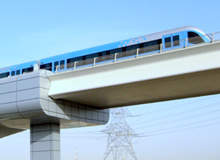
Dubai’s Road and Transport Authority (RTA) will no doubt reflect back on the opening month of Dubai Metro’s Red Line with mixed thoughts. On one hand, nearly 10% of Dubai’s population (110,000 people) embraced the driverless fully automated network within the first two days of its operation. This figured reached almost 367,000 passengers within the first week.
On the other hand, this seemingly positive reception was inevitably going to be overshadowed by news that out of the line’s 29 stations only ten were operational for its official inauguration on 9 September 2009.
Furthermore, a number of technical glitches were reported during the first week, including an incident on the first day the Metro was open to the general public when a pneumatic cable snapped, prompting the fully-loaded train to stall for more than two hours.
Despite investing some US$3.4bn on the design and build contract and drawing on the skills and expertise of such global heavyweights as the Mitsubishi Corporation, Kinki Sharyo and Thales, introducing an urban light railway on this scale was always going to prove tricky for a region so fundamentally unfamiliar with rail operations.
Dubai’s dreams
From being home to the world’s tallest skyscraper to embarking on the grandiose vision of the Palm Islands (a series of extensive artificial islands stretching off the city’s coastline), Dubai has notoriously been intent on trying to make the world sit up and take notice of its exceptional level of growth.
Slowly over the course of this decade, the city’s rise to fame has exposed, among other things, a limited transport infrastructure. Severe traffic congestion and a rapidly-growing population sparked Dubai’s ruler Sheikh Mohammed bin Rashid Al Maktoum to turn towards rail – a transport method with little historical leverage in the Middle East.
And turn to rail he did. The Dubai Metro – albeit only the current one line and ten stations worth – is the first urban train network in the Arabian Peninsula and, if all goes according to plan, will become the world’s longest automated metro network.
Yet as the city’s transport authority is quickly realising, rail infrastructure requires a softer approach than Dubai’s usual tendency of trying to complete mammoth projects seemingly overnight.
The 19 remaining stops of the Red Line are now penned for operation by February 2010. The precise timescale on which they will open, however, remains sketchy and this is not the RTA’s first failure in transparency. Confused commuters were left queuing outside Metro stations for hours on the network’s opening day, unaware that operations were due to begin at a bizarre 2pm.
Such incidents do not bode well for one of the Metro’s biggest challenges: having to overcome the steep social reliance on road transportation. With cheap fuel prices and a high level of car ownership in the region, even a complete and fully functioning Dubai Metro would struggle to immediately attract a consistent level of commuters.
At the moment the Metro seems more of a novelty item – a new means of transport for the population to visit a handful of popular Dubai shopping attractions such as the Mall of the Emirates and Deira City Centre.
There is also evidence that a percentage of passengers are struggling to get to grips with the basic etiquette of rail travel. According to the Metro’s official website, a number of incidents of people pushing onboard carriages were reported in the first week of operation, alongside a more serious incident when passengers pressed the emergency brake buttons and caused the train to switch to manual mode and stop at the next station.
How the story of Dubai Metro unfolds in the coming months and in 2010 when its Green Line is scheduled to open will therefore not simply be of interest to the rail sector, but is likely to prove an intriguing social experiment that the world will once again sit up and take notice of.
What the locals have to say
Ben Flanagan, editor of Media Week Middle East says:
"Before it launched, no one really had a clue as to whether the Dubai Metro would be a success. Doubters said no one would use it because it’s too hot to walk to stations, and that there is too much of a ‘car culture’ here. Others said it was the perfect answer to Dubai’s hideous traffic problems.
"But since the 09/09/09 launch, the rail system has proved to be a great success. Crowds flocked to use it on the opening weekend, and – even after the hype died down – the system remains incredibly popular with genuine commuters and tourists alike.
There are still problems: the opening times are ridiculous [it shuts at 11pm on weekdays] and there is no information as to when the remaining stations will open. But overall, the system is great: it’s fast and efficient, eco-friendly, and has acted to bring Dubai’s diverse mix of cultures – which previously rarely crossed – together. Dubai now feels like a proper city."
Lisa Schultz Smith, Dubai resident says:
"Dubai Metro opened on 09/09/09 in Dubai so my husband and I decided to venture down and take a ride. We found it was closed on Fridays until 2.00pm.
"We weren’t giving up just because it was closed so waited a couple of hours and, approached the experience with excitement and enthusiasm. After hours of delay, huge queues, extreme disorganisation and lots of time on our aching feet, our moods had changed considerably. Until the kinks are worked out, we believe that walking is easier and more comfortable, even in this heat."



